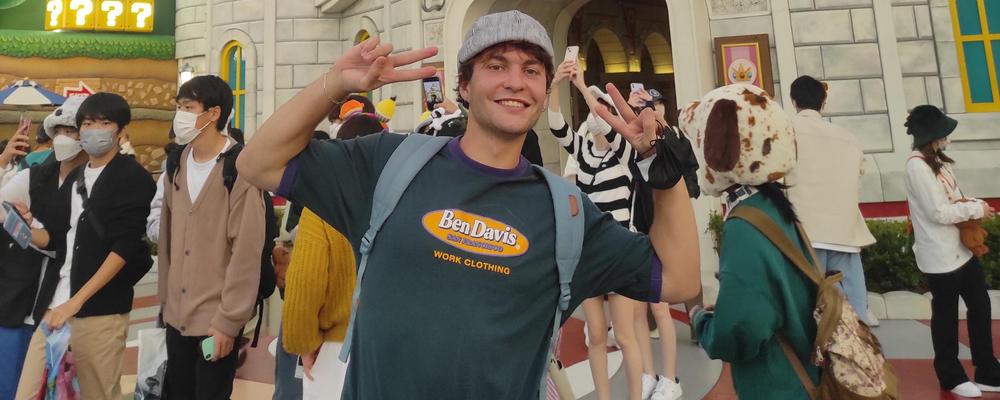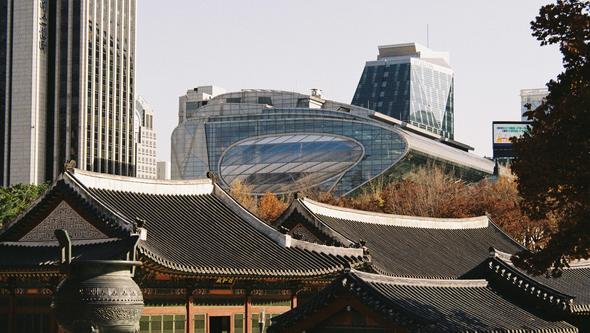
- Hem
- Aktuellt
- Hitta nyheter
- Blogginlägg: Nathan Lambert berättar om sitt utbyte i Japan
Blogginlägg: Nathan Lambert berättar om sitt utbyte i Japan
(Artikel på engelska) French student Nathan Lambert is studying MSc International Business and Trade in Gothenburg. As a part of the programme, he went to Japan for an exchange semester. This is his blog post about his experience.
Introduction
Ramen, sushi, manga, Shinto, and sake were promised when leaving Sweden for the rising sun. Firstly, I may have to disappoint, sushi is not really a thing there, and you might even struggle to find some. However, if you step away from your prejudice, you will encounter a delightful rich food culture.
Albeit I could not claim to be passionate about Japan beforehand, I was attracted by the remoteness of the culture, which might even be the furthest of any developed economy. I have always loved to travel but there were only a few places where I could see myself settling for a while, Japan was definitely one of those, truly Göteborg was another one.
Background
Coming from Lille, the former heart of the French textile industry; I decided to pursue a master's degree in International Business and Trade at Handel’s. My choice was motivated by the renown of the university combined with the blue-collar, friendly vibe of the city. I had the opportunity to continue in a French business school but was repelled by their elitist characters. Overall, I am glad about my choice, the life balance allows me to drive plenty of personal projects and encounter great people while receiving a qualitative education. Nevertheless, any prospective student must bear in mind the academic nature of the degree, which, although preparing you very well for a career in research, can appear distant from the professional world.

The first cultural clash
Landing in Tokyo in the early morning at the beginning of September, I am struck by jetlag and a temperature above 30 degrees saturated with humidity. A few steps away from the aircraft, the roman alphabet gave a way to katakana hiragana and kanji (the three writing systems), having no SIM card to help me. Hopefully, the serviceable airport was there to guide me through a bureaucratic maze, that will soon be part of my daily life. A train ticket booked (in cash), I headed to Tokyo where I would spend a night before jumping on the Shinkansen to rally Kyoto in under three hours.
Accommodation
In Kyoto, Doshisha will offer two opportunities to accommodate you. One is a male-only dorm with a shared kitchen and showers. This place is frugal and convivial, with a large share room in which you might encounter people at any time. Wi-Fi, electricity, and water were included, avoiding a lot of bureaucracy to find a supplier. You will be 15 minutes walking distance from school, and thirty minutes door to door to the centre by subway. The second place proposes more comfort but does not include the internet. It is also twice as pricy, 2500kr vs 4500kr and you must take the subway to get around since you are over forty minutes walking from school. In both cases, you will have to pay your rent in cash at the post office. Japanese people are not that comfortable with English outside of the tourist areas, albeit very helpful. So, arm yourself with patience and tackle a Kafkaesque administration with a Japanese-speaking friend newly encountered in the common area.
The courses at Doshisha BS
Mattias and I (a Swede from Dalarna), were the first students from Sweden to be received by Doshisha. We were warmly welcomed by diverse introduction activities allowing us to quickly bond with other students. Integrated into a promotion of 35 to 50 students, we assisted with a presentation of the program and were able to choose a broad array of courses in finance, marketing, innovation, Asian and Japanese business practices, sustainability etc. Options were available for students wishing to stay a quarter or a semester. The classes are organised very differently from back home. In a group of five to twenty, you attend a lecture promoting communication between the teacher and the students. Everyone is expected to share his/her opinion, creating a unique learning dynamic. Await weekly homework as it contributes to the grading process. Nevertheless, do not fear the workload, you will have time to plainly enjoy your exchange. Professors are benevolent and understand your condition of exchange students!
The city of Kyoto and its surroundings
Kyoto was during the Edo period and until 1868 the capital of Japan. With that said you can start to imagine the cultural richness of the city. Accommodating over a thousand temples, the city offers endless sightseeing and strolls in its alleyways. Although there are a couple of very tourist places, as a long-term resident you will continuously be surprised by the diversity of activities available. Kyoto is also ideally located within a thirty minutes train ride, in a triangle of cities including Osaka and Kobe. Osaka depicts a modern Japan, the municipality hosted clubs, skyscrapers, and ten-story malls and emits a streetwear vibe. You can reach its city centre from Kyoto in under half an hour’s train ride. Kobe seems rather industrial and more authentic. Its marketplace is worth a glance, and along with Kyoto, both cities propose tremendous hike paths.
Travelling during your exchange
Since you are requested to be present in Japan by the beginning of September, although the courses start in October, you will have a few weeks to travel across the country. As previously said, the University workload gives way to a lot of free time and with a bit of organisation, you should be able to be gone for three to four days in a given week. Due to the high quality of the public transport, I would personally advise you to visit remote places first, keeping the closest cities for weekend trips. You will encounter primarily international students; they will certainly be open to the world and pleasant company. Bear in mind you will live with people that did the choice to live in Japan for a while, most come from prestigious institutions, driving precious cultural sharing.
Bounding with Japanese is far from impossible if you are willing to. You will simply need to be outgoing, Japanese people are very open although a little introverted by my French standard (which might also be due to my poor Japanese skills). University students like to practise their English.
Some friends and I were lucky enough to visit the Okinawa islands and Seoul. Both are worth the flight especially since you are already in this region. Seoul is home to a totally different culture with vibrant nightlife, whereas Okinawa offers tropical landscapes with a warm climate and a unique entanglement between Japan and the US.
// Nathan Lambert
- Studies in the second year of the Master's programme in International Business and Trade at the School of Business, Economics and Law at the University of Gothenburg
- Comes from Lille, France
- Did an Exchange semester in Kyoto, Japan
